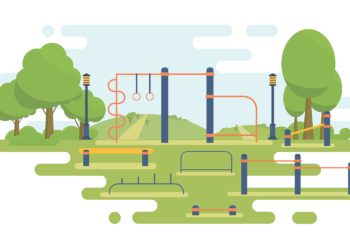‘Tis the season to be jolly… It’s a festive time of year, and students have even more to be excited about: Winter break is coming. That means New Year’s Day is right around the corner, and students will return from their much needed break with resolutions fresh in their mind and motivations at high gear. Now’s the time to prepare fitness facilities for the flux in use by checking current equipment for needed repairs or replacements.
Resistance Bands
Resistance bands, also known as strength bands or exercise bands, are elastic bands commonly used in strength training by providing muscle-building tension. They can be used in low-impact exercises or more intense exercises where the user is trying to increase vertical leap or speed. These bands can be resilient, yet through stretching and use, they can lose their elasticity. Check bands for signs of breakage. Week spots will have slight discoloration, though if bands have layers beginning to peel away, it’s time to replace them.
Medicine Balls
Whether students are interested in CrossFit, athletic conditioning or specialized training, medicine balls are a great tool as a vast variety of exercises help with any of these areas. With as common and versatile as these balls are, it’s common to see wear occur over time. Weak spots are most noticeable while in use when the interior material puffs out upon impact. Giving balls a once-over is another way to find weak spots. Look at the seams for gaps or torn threading. The great thing about medicine balls is this isn’t the end; they are often times easily repairable. Rubber balls can be fixed by sanding down around the leak, cleaning the area and applying a tire patch. Vinyl balls can be resewn with heavy-duty thread. For low maintenance and minimal wear, balls made of Kevlar® are ideal. They are considered the most durable on the market.
Plyometric Boxes
Vinyl plyo boxes are low impact and reduce threat of injury vs those made of metal. They are lower in cost yet can tear at the seams over time. They are still worth the cost as these boxes can be easily repaired. Just like vinyl medicine balls, they can be resewn with heavy-duty thread.
Weightlifting
Weightlifting equipment is a staple in the fitness facility. Given the heavy duty material used to make bars, weights and racks, these products usually have long life spans. It is wise to periodically check the bars with a leveler, though. If there is a bend to the bar, it becomes harder to keep weights on, especially if a collar isn’t being used. Check the bar with the leveler, and if it is curved it’s time to replace the bar.
Kettlebells
Kettlebells have become a staple in the workout room and weightlifting industry. They provide whole-body movements and conditioning. Most kettlebells, especially those made of single cast iron or steel, are built to last and will sustain little to no damage over time. It is still good practice to check these along with everything else in the fitness room. With iron and steel kettlebells, check for rust. If they have been properly cared for, rust is unlikely. In the event there has been some rust accumulation though, this can be fixed by rubbing the rust with a scouring pad. Don’t use steel wool as it will scratch the surface. If the rust is stubborn, paint over it to block it from exterior elements. For plastic kettlebells, these need to be checked for cracks and replaced if needed.
If the campus fitness facility is stocked with proper, quality equipment, it’s likely there will be minimal wear even from some of the most devoted students. No matter how likely they are to uphold though, it’s always best to give them a regular checkup. Following simple steps will give equipment extended life and prepare the facility for the students arriving in the spring.
Matt Johnson is the Resident Fitness Trainer and Sales Manager for MASA, an online sporting goods store. Contact Matt at mjohnson@masa.com or visit sportsadvantage.com.










